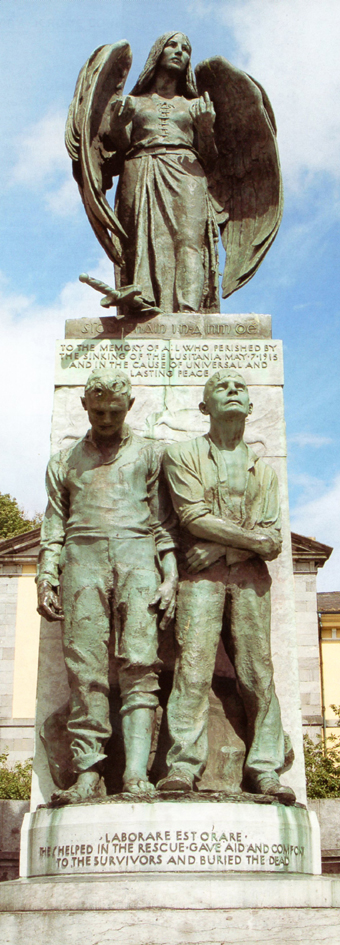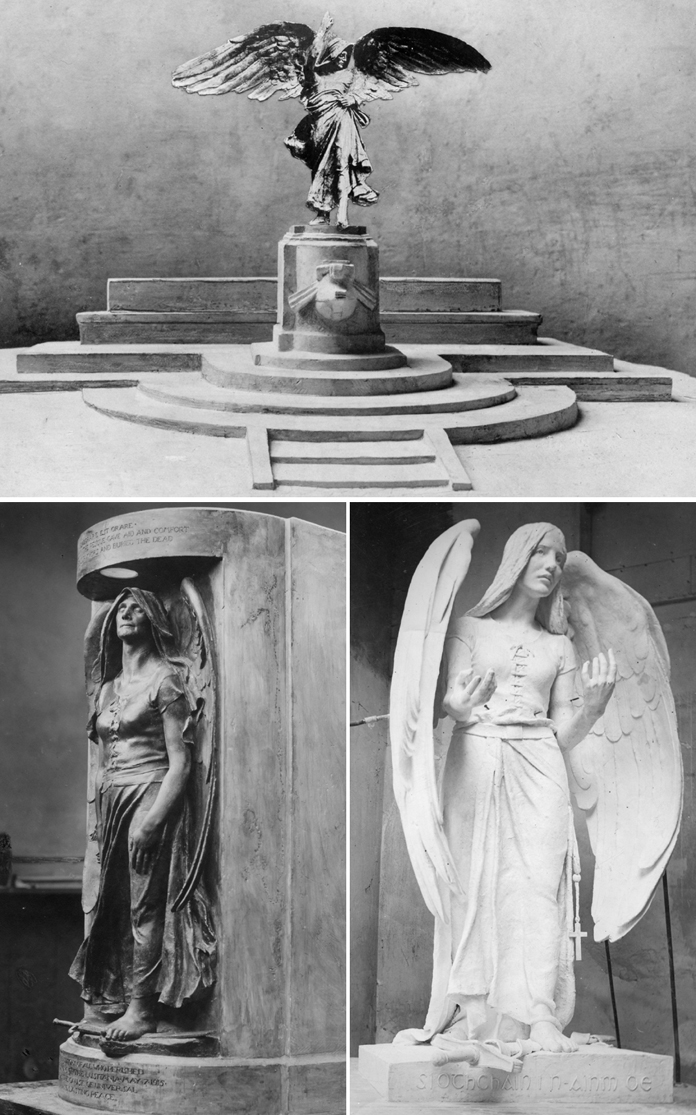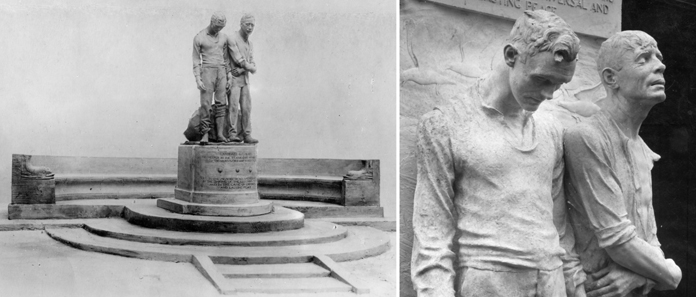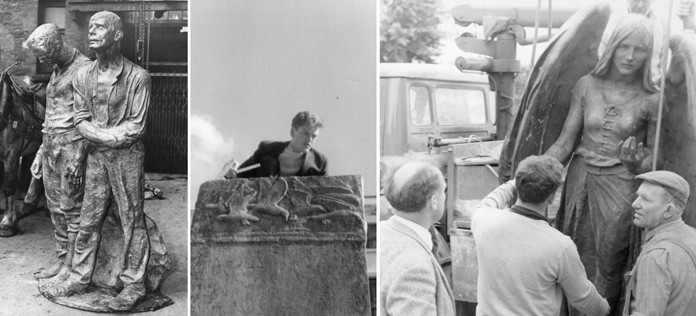Building of the Month - May 2015


Figure 12: Lusitania Peace Memorial in 2007. Photograph by Sandra O’Brien for the National Inventory of Architectural Heritage

Figure 1: Lusitania Peace Memorial, Casement Square, Cobh, County Cork. Photograph by Michael Martin |
This sculptural masterpiece honours ‘all who perished by the sinking of the Lusitania‘ on the 7th of May, 1915, its Mourning Fishermen evoking the heroism of local people who ‘helped in the rescue, gave aid and comfort to the survivors, and buried the dead’, its Angel of Peace, her foot on a sword, appealing for an end to war: Síothcháin i n-ainm Dé [1].
By Kerry-born Jerome Connor (1874-1943) [2], and one of his finest works, complementing the town’s 1850s market house [3] and the flanking Victorian terraces, it is hard to believe that such a familiar icon of Cobh, honouring a moment when the prompt action of this maritime community saved hundreds of civilian lives in the midst of the First World War, took over thirty years to complete; that the memorial, like RMS Lusitania herself, needed rescuers; and that the vicissitudes of the commission would dramatically alter the course of the sculptor’s career. Plans for a Cobh memorial ‘to stand at the gateway between the old and the new worlds as a permanent and mute appeal for world peace’ [4] were initiated in 1925 by a New York Lusitania Peace Memorial Committee with Franklin D. Roosevelt and other public figures as members, but led by relatives of leading American victims: millionaire Alfred Gwynne Vanderbilt’s son William; theatre impresario Charles Frohman’s brother Daniel; and Elbert Hubbard II, son of Arts and Crafts promoter Elbert Hubbard. It was to be financed by public fundraising in the United States. The sculptor had a personal link to the tragedy. Jerome Connor and his wife Anne Donohue met in 1899 as fellow artisans at Elbert Hubbard’s Roycroft Arts and Crafts colony, at East Aurora, NY, and were close to his family: in parallel with the Cobh memorial, Connor would also design a statue of Hubbard himself, funded by his admirers, a twice life-size figure for the Roycroft campus. Connor moved to Dublin and opened a new studio to work on both projects. However, in a greatly changed Ireland, the Lusitania theme had become politically sensitive. Not only was Queenstown now Cobh, but the site, Scott’s Square, was now Casement Square,recalling German support for the 1916 Rising. Approval for such a memorial at one of the country’s key entry points would take time. Connor, while welcomed as a distinguished visitor, making portraits of cabinet ministers, entering designs for the Irish coinage [5], and known for his nationalist work, had to stress the memorial’s theme of world peace. When in August 1926, fellow Irish-American sculptor Andrew O’Connor (being namesakes, and because they both had Vanderbilt patrons, they were often confused) sought approval for a privately funded Lusitania Memorial on a headland near the site of the tragedy, Kevin O’Higgins, Minister for Home Affairs, made clear that, despite the remote location, his government ‘would not welcome…a memorial of the kind referred to’. Meanwhile at External Affairs, Minister Desmond FitzGerald stipulated that Jerome Connor and the New York committee should ‘approach the Irish government through the United States government’. By March 1927 a protocol to cover this was agreed, Cork City Commissioner Philip Monahan was delegated to make arrangements, and the site was made available by Cobh’s Urban District Council [6]. Connor had completed his full size plaster Elbert Hubbard in July 1929, shipping this to New York to be cast in bronze. He then addressed Lusitania, experimenting on site with timber and canvas to visualise his proposal in its architectural setting and, by November 1929, creating a one-third scale model in plaster in the Dublin studio. This was different from today’s memorial. With no Fishermen, semi-circular seating or carvings,it consisted of an austere Angel with swirling draperies, an energised, challenging figure, unlike its present successor, to be viewed best at night, in Connor’s words, ‘from the harbor, under the perpetual light which will never go out’ [7]. Had the onset of the Depression not halted fundraising, stalling progress for some years, this figure would likely have been realised, and unveiled a year or two later. In the event, the project’s later relaunch involved major design changes. |
In 1933, with committee member Franklin D Roosevelt now President, the memorial’s prospects revived. Grace Hartley, married to Louis McHenry Howe, Secretary to the President, became involved. The committee’s secretary and treasurer, Washington political hostess Mrs J. Borden “Daisy” Harriman, persuaded Gertrude Vanderbilt Whitney, Alfred Gwynne Vanderbilt’s sister, a patron of the arts and herself a sculptor, to offer funding, despite the fact that Mrs Whitney had long favoured her former tutor – and Connor’s rival – Andrew O’Connor, working with him on various projects [8].
Mrs Whitney’s views now had to be accommodated. Her experiences in the Great War, when she had used her wealth to provide hospital care for injured soldiers in France, had drawn her to portrayals of human suffering and endurance. Therefore, over several months in 1933, and between visits to the committee in New York, Connor made scale models of Mourning Fishermen in the Dublin studioand also experimented with Angels to complement these. A final design was approved early in 1934.

Figures 2-4: Studio scale models: Angels. Anti-clockwise from top: As the design evolved in 1933 to include Mourning Fishermen, Connor set aside his 1929 Angel of Peace; experimented with a second Angel with the Fishermen above; and then arrived at a final design [9]

Figures 5-6: Studio scale models: Fishermen. Left to right: Initially the Fishermen were to stand alone. Retaining the front steps of the early layout, Connor then introduced a semi-circular seat and dolphin carvings. With the Angel reinstated, the Fishermen were placed in front of the plinth
Today’s memorial, arguably much more accomplished than its predecessor, was thus, in concept at least, the work of two sculptors. Connor would not have had a problem with this. His approach was collaborative. In Tralee in 1931, faced by local demand for a Pikeman, he set aside a planned Liberty figure [10]. InKillarney in the same year, he agreed to alter his Éire,asword-bearing image of sovereignty, to the familiar, less challenging Erin with her harp [11]. His maquettes could be detailed – in photographs they can be misread as full size figures – but they were always open to change.
At the end of 1934 Connor returned to Dublin to realise the Cobh memorial. By 1938, when work stalled due to his other financial difficulties, he had enlarged the three figures, installed the stonework on site, and realised the Fishermen in bronze. At the time Dublin had no lost wax bronze casting service, but with his foundry training Connor could carry out all stages of such work himself, using industrial facilities. He created the Mourning Fishermen, section by section, in this way in Dublin’s Hammond Lane iron foundry. Believed to be the first monumental lost wax bronzes made in Ireland, they were shown at the 1942 RHA.

Figures 7-8: Jerome Connor, pictured on the left, completed the Lusitania stonework and carvings in 1936-37. On his death in 1943 the figures for the memorial were in storage in Dublin: the bronze Fishermen at the Hammond Lane foundry and the plaster Angel in his former studio at 2 North Circular Road
After Connor died, key individuals in the Irish arts world acted to ensure Lusitania was realised. Chief Justice Conor Maguire, and Constantine P Curran, vice-presidents of the Friends of the National Collections of Ireland (FNCI), liaised with the surviving members of the New York committee and arranged to clear the foundry debt on the Fishermen. These were installed in Cobh in 1953 [12]. However, the fragile plaster Angel, given in 1945 by Connor’s solicitors to sculptor Domhnall Ó Murchadha (later RHA & Director, NCAD) would need to be cast abroad. Initially there was little prospect of financing this, but in 1965, the fiftieth anniversary of the sinking, Taoiseach Seán Lemass, concerned for US sensibilities, arranged for Arts Council funding [13], and the bronze was then cast in the Tomassi foundry, Pietrasanta, Italy, and installed in Cobh, completing the memorial, in July 1968.

Figures 9-11: Realisation, 1953-1968. Left to right: The Fishermen at the Hammond Lane foundry, 1953; Sculptor Fred Conlon (1943-2005) in Cobh, 1965: he assisted Domhnall Ó Murchadha in conserving the plaster angel before it was shipped to Italy for casting [14], and also helped on site; The Angel arrives in Cobh, 12 July 1968: Ó Murchadha is on the left
Among artists, it was a sense of Connor’s greatness as a sculptor that drove the campaign to complete the memorial, but its local significance is that it recalls, especially in this the Lusitania centenary year, a moment when the people of Cobh did all they could to help others in the face of a major tragedy.
For Connor’s clients, the household names among the Lusitania dead and the survivors’ accounts, had made that tragedyan image of the horror of war, a reminder of the need to work for peace. Appropriately, in an international port, their message was for the world. Connor, however, was aware of the need to engage with his host community. His Gaelic and Latin texts, Síothcháin i n-ainm Dé and Laborare Est Orare [“to work is to pray”] gave an explicitly Irish and Catholic inflection to the memorial’s universal images of prayer and sacrifice. Dublin neighbours posed for the figures, and the rosary at the Angel’s girdle echoed his Angels of the Battlefield in Washington, D.C., where the nuns caring for America’s Civil War wounded are similarly portrayed.
Yet, however worthy the cause, and however sensitive the artist, for outsiders to place a memorial in a town’s main civic space carried some risk. In 1936, Connor paid tribute to the Town Clerk of Cobh, Arthur Powell, and to Council Chairman Séamus Fitzgerald of Fianna Fáil and ‘the majority of the members’ who had ‘always been gentlemanly and helpful to the undertaking and to himself’ [15] but as he was discovering, they were subject to many pressures. In 1930, with the foundations laid, they faced a ‘delegation of residents of the Square and other parties who object to the site chosen’ claiming ‘that the memorial will obstruct the view of the business houses immediately behind it’ [16]. By 1934, with the project stalled, there was irritation: ‘We do not mean any disrespect to the people who lost their lives or to their relatives, but we have had that unsightly concrete in the town square for four years’ [17]. Had Mrs Whitney’s funding arrived more promptly, the memorial should have been ready in 1936 or 1937, but with only the stonework in place – the steps, seating, plinth, and the associated dolphin and seagull carvings – it was now proposed to remove these, but more moderate counsels eventually prevailed [18].
In his American years, Connor’s skill at voicing clients’ ideals in accessible imagery meant that he was seldom without the prospect of work, but in the Depression, Lusitania was his one paying commission. He was committed to two other projects, the Pikeman for Tralee, and Éire,honouring Kerry’s Gaelic poets, for Killarney, but here his brother in the United States had loaned him his artists’ fees, the clients covering only the production costs. By mid-1933 Éire was at full size in plaster, with the plinth ordered, the foundry waxes prepared, a small section already cast in bronze, and half the local funds paid over, but the Lusitania redesign had to take priority. The Killarney committee, however, saw this as a breach of contract, and went on to win a High Court case for a return of their monies, though to no effect, as in 1938 Connor chose bankruptcy and court proceedings were then stalled. He now turned to making a living in Dublin by exhibiting and selling small bronzes, but he had lost his old studio, and when he died in 1943 the fate of Lusitania was in considerable doubt until Chief Justice Maguire moved to resolve matters.
Today, the National Gallery of Ireland holds the blueprints for both the 1929 and 1934 Lusitania designs, in addition to its own Connor bronzes and many of Connor’s studio plasters. Dublin has three civic works, and Annascaul in Kerry, Connor’s birthplace, has its own special exhibition of his sculpture. Yet had he completed Lusitania, there is much evidence that he would have then returned to the United States, leaving a quite limited Irish legacy. Instead, forced to stay on in Dublin because his plans for memorials in his native Kerry went awry, he found respect and support among the city’s artists and collectors, as is clear from the inventory of over one hundred bronzes, mostly from these last years, in Irish collections today. And this goodwill proved to be enough, despite the limited state supports of the era, to ensure that his Lusitania would ultimately be realised as he intended.
Giollamuire Ó Murchú is an architect and art historian and the author of Jerome Connor: Irish American Sculptor 1874-1943 (1993) and articles on Connor in the Dictionary of Irish Biography and in Art and Architecture of Ireland. His parents, sculptor Domhnall Ó Murchadha RHA (1914-1991) and art historian Máirín Allen (1912-1988), together with Connor‘s family, played a central role in preserving and researching Connor‘s work and in completing the Lusitania Peace Memorial.
| 1 | In modern spelling Síocháin in ainm Dé [“Peace in God’s name”] |
| 2 | Allen, Máirín, “Jerome Connor”, in The Capuchin Annual (1963, pp.347-68; 1964, pp.357-69; 1965, pp.365-90) was for long the only extended study of the sculptor. The author’s Jerome Connor, Irish American sculptor 1874-1943 (Dublin, 1993) for the National Gallery of Ireland exhibition of the same name, and subsequent entries in Günther Meißner (ed.), Allgemeines Künstlerlexikon, XX (1998), and the Royal Irish Academy’s Dictionary of Irish Biography (2009) and Art and Architecture of Ireland (2014) update this. All are drawn on in this account |
| 3 | Later the Cobh Urban District Council offices and now Cobh Library |
| 4 | Irish Times (18th September 1936) |
| 5 | Now on display in the Airgead exhibition,National Museum of Ireland, Collins Barracks, Dublin |
| 6 | NAI, DFA GR/658 |
| 7 | In a postcard to his daughter Marjorie Connor in Washington, D.C., in or before July 1932 |
| 8 | Soderman, Doris F, The Sculptors O’Connor (Worcester MA, 1995), passim |
| 9 | Figures 2-11 are archive material in the author’s collection, cf. Jerome Connor, Irish American Sculptor 1874-1943, p.84 |
| 10 | Photos of maquettes: Liberty in Kerryman (7th March 1931), Pikeman in Irish Times (25th September 1931) |
| 11 | Photo of initial version in Irish Press (30th October 1931) |
| 12 | Irish Press (12th February 1953) |
| 13 | Molony, Senan, Lusitania, an Irish Tragedy (Cork, 2004), pp.158-9 |
| 14 | Harte, Jack, Unravelling the Spiral, the Life and Work of Fred Conlon (1943-2005) (Dublin, 2010), pp.47-8 |
| 15 | Irish Press (24th March 1936) |
| 16 | Irish Independent (13th November 1930) |
| 17 | Sunday People (16th September 1934) |
| 18 | Irish Independent (5th October 1936) |
Back to Building of the Month Archive